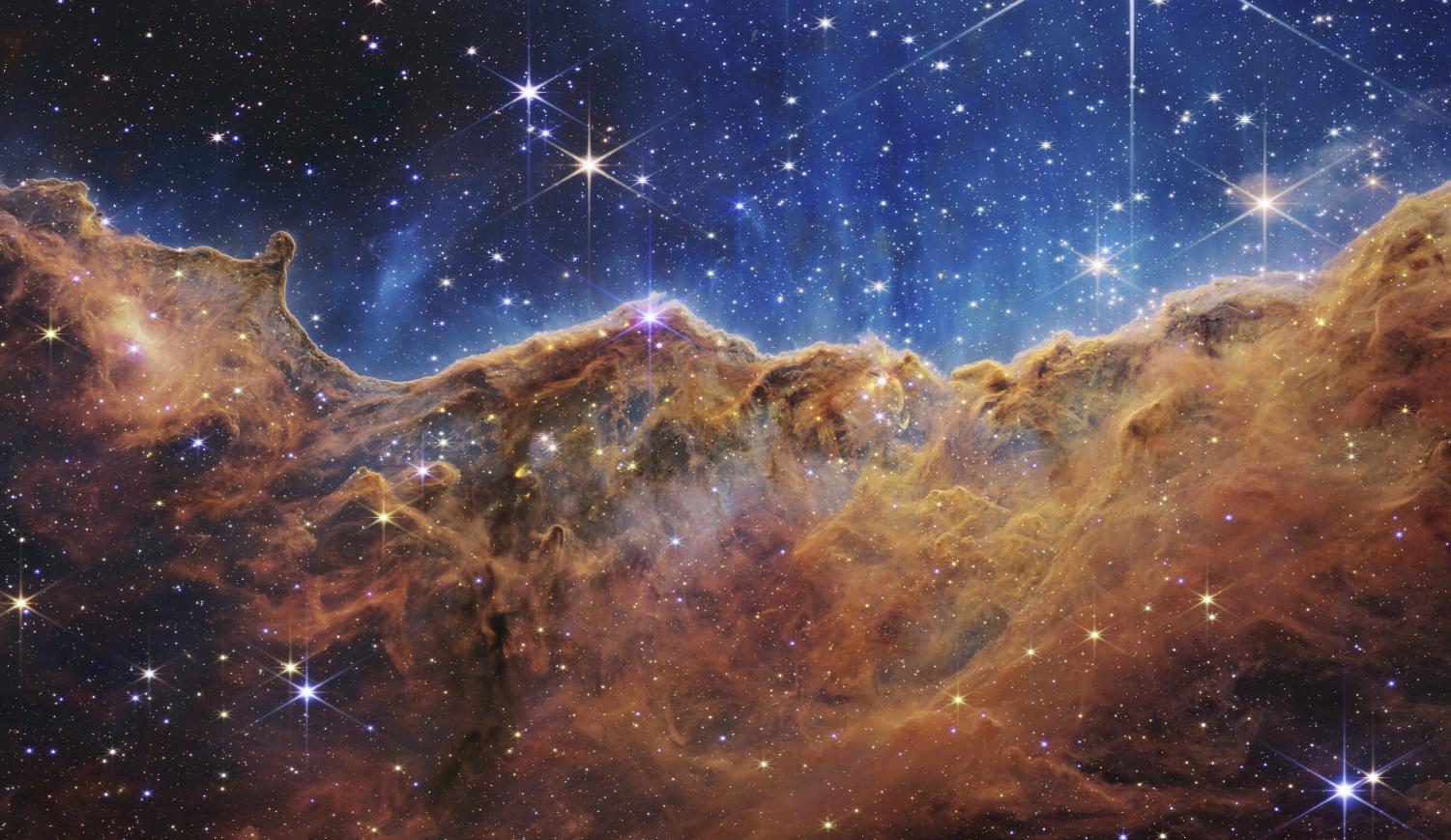Editorial | The James Webb Telescope is revolutionary


This image released by NASA on Tuesday, July 12, 2022, shows the edge of a nearby, young, star-forming region NGC 3324 in the Carina Nebula. Captured in infrared light by the Near-Infrared Camera (NIRCam) on the James Webb Space Telescope, this image reveals previously obscured areas of star birth, according to NASA.
President Joe Biden presented an image captured by the National Air and Space Association’s James Webb Telescope on Monday. The piece of technology has produced the deepest infrared image of the universe that has ever been taken and caused much excitement for scientists and nonscientists alike.
Despite the image having an intriguing quality, what exactly is special about shiny six-point stars and warped burnt-orange blobs? Well, NASA describes the image as “the size of a grain of sand being held at arm’s length, a tiny sliver against the universe.” Basically, this is a very small snapshot of the very expansive universe we have only begun to understand. It is composed of different wavelengths that traveled over a period of 12.5 hours — a fraction of the time the Hubble Space Telescope took to capture images at its deepest field of visibility.
The image presents galaxies, some that are over a billion light-years away — ones that humans all across the world are able to see for the first time ever — making this measurable feat comparable to people witnessing the first images of Earth from outer space. Humans are witnessing the past in the present, and there is something quite remarkable about living through this historical moment.
Despite this scientific wonder being understandably awesome, the specifics are mostly lost on people who are unfamiliar with scientific jargon. Thankfully John Green — brother of beloved TikTok biologist and all-things-science extraordinaire Hank Green and famous author of multiple books that made middle schoolers cry — took to TikTok to address a commenter’s confusion, shared by many, on his brother’s video explaining the significance of the image. John Green prefaced his explanation by stating that light travels at a constant speed, so when we see light from the sun hitting Earth, we experience that light minutes after it first begins to travel due to the sheer distance between Earth and the sun. Green said sunlight reaches Earth after seven minutes, but according to the Public Broadcasting Station the time is just over eight minutes.
Regardless, the principle — defined by Albert Einstein in 1905 — demands that we recognize that the Webb telescope is revealing images of stars tens, thousands, millions and billions of years away from the lens. It has revealed galaxies and stars substantially farther than anything ever produced. Green said the telescope allows us “to see much much farther away … like almost back to the beginning of the universe far away.”
Within the picture alone, numerous galaxies are out on display. Hank Green stated in his TikTok that, “these little, weird arcs and smudges … well, they are galaxies but they are not where they appear to be. They are actually behind what is here, which is a giant massive cluster of galaxies so big it is warping space and it is making it so that the light passes around them and makes them focus on things that are very much farther away.”
Whether you understand the significance of this image or see it as a beautiful picture capturing our universe, this image has allowed us all to see the past right before our eyes. And thank you to the Green brothers for making that reality known to us simple social media users.
Recent Posts
SGB addresses concerns about ICE presence on campus, hears SJP lawsuit against administration, approves governing code bill
At its weekly meeting on Tuesday at Nordy’s Place, Student Government Board heard concerns about…
ACLU of Pennsylvania sues Pitt over SJP suspension
The ACLU of Pennsylvania filed a federal civil lawsuit against the University of Pittsburgh and…
Marquan Pope: The ultimate shark
One of the most remarkable things about sharks is that an injury doesn’t deter them.…
Who Asked? // Do we really get a summer vacation?
This installment of Who Asked? by staff writer Brynn Murawski mourns the seemingly impossible perfect…
Notes From an Average Girl // Notes from my junior year
In this edition of Notes From an Average Girl, senior staff writer Madeline Milchman reflects…
Meaning at the Movies // The Power of the Movie Theater
In this edition of “Meaning at the Movies,” staff writer Lauren Deaton discusses her love…

